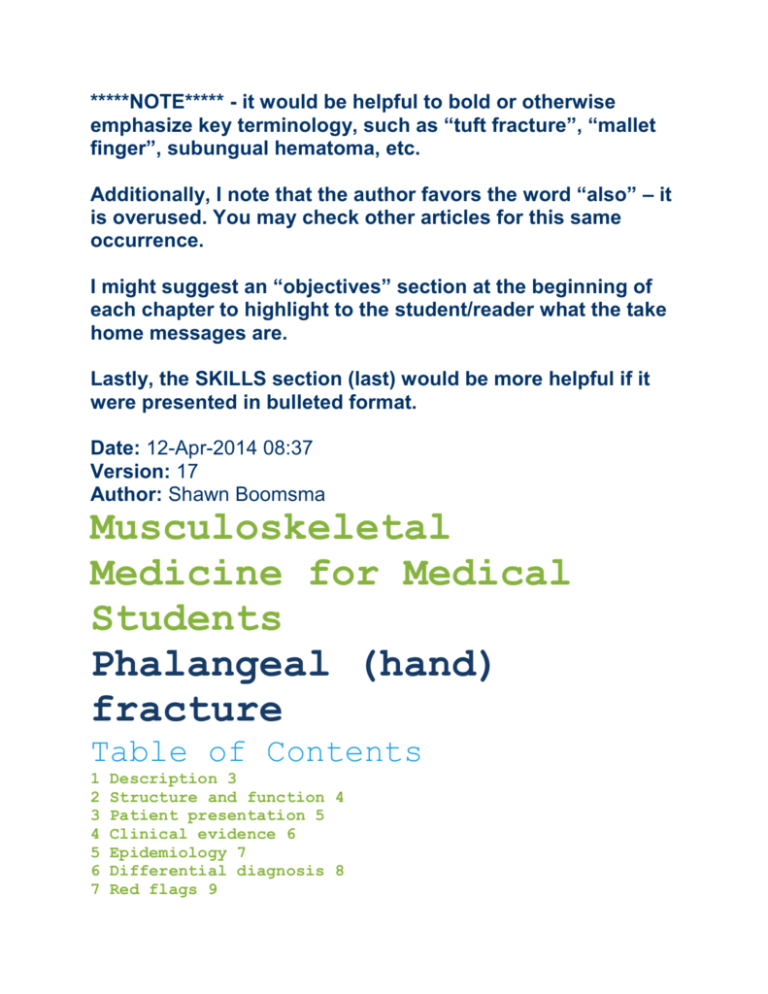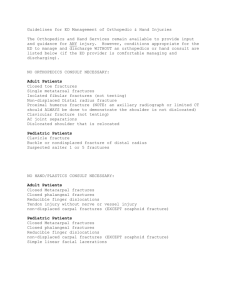Penn_Edit1 - OrthopaedicsOne
advertisement

*****NOTE***** - it would be helpful to bold or otherwise emphasize key terminology, such as “tuft fracture”, “mallet finger”, subungual hematoma, etc. Additionally, I note that the author favors the word “also” – it is overused. You may check other articles for this same occurrence. I might suggest an “objectives” section at the beginning of each chapter to highlight to the student/reader what the take home messages are. Lastly, the SKILLS section (last) would be more helpful if it were presented in bulleted format. Date: 12-Apr-2014 08:37 Version: 17 Author: Shawn Boomsma Musculoskeletal Medicine for Medical Students Phalangeal (hand) fracture Table of Contents 1 2 3 4 5 6 7 Description 3 Structure and function 4 Patient presentation 5 Clinical evidence 6 Epidemiology 7 Differential diagnosis 8 Red flags 9 8 Treatment options and outcomes 10 9 Risk factors and prevention 11 10 Miscellany 12 11 Key terms 13 12 Skills 14 Phalangeal (hand) fracture Version 17 3 1 Description Phalangeal fractures of the finger are typically due to direct blows to the hand. Most phalangeal fractures are treated non-operatively with splinting, but more serious and unstable fractures may require surgical treatment to prevent stiffness, malunion and decreased function. Phalangeal fractures may be seen in the setting of soft tissue injuries (e.g., nail bed, flexor tendon) that are of more pressing concern. Phalangeal (hand) fracture Version 17 4 2 Structure and function The phalanges form the fingers and thumb of the hand. The thumb has 2 phalanges (proximal and distal) and the other digits have 3 (proximal, middle and distal) for a total of 14. Each phalanx is comprised of a base, proximally, and a head, distally, with the shaft between them. The articulation of the proximal and middle phalanges forms the proximal interphalangeal joint (PIP); and the articulation of the middle and distal phalanges forms the distal interphalangeal joint (DIP). These are hinge joints, capable of flexion and extension. The ulnar and radial collateral ligaments along with the joint capsule are the primary stabilizers. The volar plate, a band of fibrocartilaginous tissue, prevents hyperextension. The flexor and extensor tendons attach to bone at their respective insertion sites, and bone injuries there (typically avulsions) can lead to functional failure of the affected flexor or extensor tendon. annotated xray of hand showing regions of phalanx and soft tissue attachment points Phalangeal (hand) fracture Version 17 5 3 Patient presentation Patients typically present with pain and swelling and a history of a blow or crush to the injured digit. Ecchymoses may be present. Distal phalanx fractures are usually caused by a direct blow or crush, which can cause nail bed injuries (seen as a hematoma beneath the nail). clinical photo of crushed finger suggesting bony injury Tuft fractures are fractures of the cancellous bone at the distal tip. The integrity of the flexor and extensor tendons should be assessed with any injury to the distal phalanx. Nailbed injuries are also common as part of tuft fractures; a subungual hematoma may need to be drained and the nailbed repaired after removing the nail. The middle phalanx is more susceptible to a direct blow to the dorsal side. The middle phalanx is also injured with an axial force, perpendicular to the shaft. A direct blow commonly causes proximal phalanx fractures but rotary forces and hyperextension can also cause injury. Proximal phalanx fractures are often angulated at the time of presentation (independent of mechanism) as muscle forces deform the unstable shaft. The collateral ligaments and volar plate at the MCP joint stabilize the proximal portion and the extensor tendon pulls the distal fragment into extension. Phalangeal (hand) fracture Version 17 6 4 Clinical evidence AP, lateral and oblique images of each injured digit are needed. The lateral view should be taken so the other fingers do not obscure the injured digit. The oblique view can help diagnose fractures of the heads. Radiographs should be examined for angulation and shortening as well as intra-articular fractures. Rotational deformities are usually diagnosed via physical examination rather than radiographic findings. If an intra-articular fracture is suspected but not seen on plain radiograph, CT can be useful. xray of intra-articular phlanx fracture xray of oblique displaced phlanx fracture Once the fracture is reduced and splinted, post-splinting radiographs are taken. There should be no finger rotation, less than 2 mm of displacement or shortening and less than 10 degrees of angulation. Phalangeal (hand) fracture Version 17 7 5 Epidemiology Phalangeal fractures are common. They are seen in athletic and work-related injuries. The precise incidence is not known, as many patients do not seek medical care. Phalangeal (hand) fracture Version 17 8 6 Differential diagnosis Collateral ligament tears are seen when there is forced ulnar/radial deviation, especially in the PIP joint, (i.e., “jamming” of the finger). Applying gentle varus and valgus force to the joint can test the ligaments. Soft tissue trauma can cause swelling within the (confined) fibrous septae found in the pulp of the distal phalanx; blood can also accumulate. Trauma can also lead to open lacerations (with neurovascular dysfunction), avulsion of the skin, and nailbed injuries, such as subungual hematomas. Flexor/extensor tendon injury may be seen with middle and distal phalangeal fractures. Mallet finger is an extensor tendon injury from a flexion blow to an extended DIP joint. It is seen as an inability to actively extend the DIP, leading to a flexion deformity of the DIP joint. Jersey finger is a flexor tendon injury (FDP) from forceful extension of the flexed DIP joint. Injury typically occurs when the finger is caught on a jersey, usually while tackling, and most commonly affects the fourth digit. Phalangeal (hand) fracture Version 17 9 7 Red flags Loss of rotational anatomic alignment. Comminuted, oblique, and spiral fractures are more likely to have loss of rotational alignment Soft tissue wounds with fracture suggest possible open fractures with soft tissue injury. Dysfunction of flexion or extension of each phalanx. This can signal a middle phalanx base fracture, as the base of the middle phalanx is the insertion site of the flexor digitorum superficialis tendon. Loss of two-point discrimination (normal is 4-5 mm wide) or capillary refill (normal is less than 2 seconds). (clinical photo showing to how Check for malrotation of the proximal phalanx by flexing the MCP and PIP joints with the forearm in supination. Normally the fingers point towards the scaphoid with no overlap or rotation). Phalangeal (hand) fracture Version 17 10 8 Treatment options and outcomes The goal of treatment is to restore congruence of joint surfaces as well as anatomic alignment. A majority of non-displaced fractures of the distal phalanx can be splinted with the DIP joint in extension for 3-4 weeks. Most non-displaced proximal phalangeal fractures can be managed with a radial or ulnar gutter splint. clinical photo of non op rx of phalanx fracture, not that it's interesting but to balance subliminal message of having only surgical picture Active range of motion should be started after 3 weeks, with clinical healing (no pain with palpation or movement) taking 6-8 weeks to occur. Ice, elevation, and limitations of use can also aid healing. If the nail is separated from the nail root, it should be gently irrigated and then placed beneath the eponychium (cuticle) in order to assist in future nail growth. Referral to a hand surgeon is needed with middle phalanx base fractures (as this is the insertion site of the flexor digitorum superficialis tendon), comminuted, rotational, intra-articular, oblique, and spiral fractures. Displaced or angulated fractures unable to be reduced adequately also need prompt referral. Surgical options include extension block splinting with Kirschner wires, closed reduction and internal fixation (CRIF) and open reduction and internal fixation (ORIF). figure: xray of ORIF phalanx fracture The outcome of phalanx fractures depends on many factors, including the forces causing the injury, patient compliance, type of treatment, length of immobilization, and medical expertise. Stiffness is one of the most common complications following phalangeal fracture, correlating with the amount of soft tissue injury and age of the patient. Some degree of stiffness occurs in greater than 50% of proximal phalangeal fractures. Malunion/deformity is common, especially with nonoperative treatment of fractures that should have been treated surgically. Osteotomy is performed to correct the deformity. Nonunion is rare but is most commonly seen with distal phalangeal fractures, especially tuft fractures. However, non-union of tuft fractures is typically not clinically significant. The union of the two fragments is from fibrous union rather than osseous union. Post-traumatic arthritis is a potential complication of intra-articular fractures in particular. Phalangeal (hand) fracture Version 17 11 9 Risk factors and prevention Individuals playing ball sports (basketball, football, baseball) are at a high risk for fractures as well as those with bone/joint disease (osteoporosis) and poor nutrition. Elderly patients are at a higher risk due to their increased likelihood of falls. Phalangeal (hand) fracture Version 17 12 10 Miscellany Wearing proper gloves and protective wear can decrease the chance of work-related phalangeal fractures. The plural of phalanx is “phalanges” and the adjectival form is “phalangeal”. Etymology: The ancient Greek word “phalangos” means "line of battle”, referring to a tight array of 800 soldiers. The fingers, closely opposed, may be thought to resemble an infantry row –at least to the folks who thought that the scaphoid looked like a boat, or that the coracoid process of the scapula resembles a raven's beak. Phalangeal (hand) fracture Version 17 13 11 Key terms Phalanges, phalangeal, fracture, distal, middle, proximal, tuft, nailbed, jersey, mallet, finger, PIP, DIP, FDS, FDP Phalangeal (hand) fracture Version 17 14 12 Skills Accurately diagnose fractures on radiographs. Understand and demonstrate testing of FDS and FDP. Apply a radial or ulnar gutter splint. Describe and demonstrate testing for radial and ulnar digital neuropathies. Be able to describe a fracture with proper terminology.








